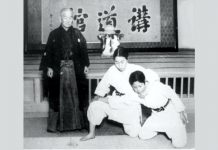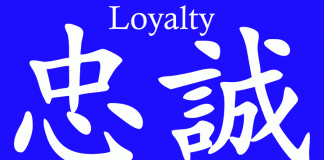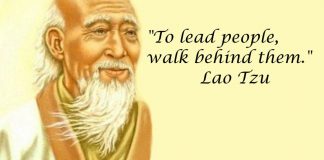‘Civility costs nothing, and buys everything.’ Mary Wortley Montagu (1689-1762)
In boyhood my grandfather once asked me what I wished to be when I grew up. I answered in all seriousness, ‘A cowboy!’ I couldn’t understand why he laughed since I often went to the cinema on Saturday mornings to watch Roy Rogers and co., and thought that the life of a cowboy must be wonderfully exciting. Also, the plots were always easy for me to fathom: the good guys wore the white hats and the baddies the black. It was not until much later that I realized most people in the real world wear grey. On occasions, I saw other movies. One drama in particular I well remember was the 1948 production of The Winslow Boy by playwright Terence Rattigan (1911-1977). There was nothing in the scenario that particularly interested me at such a young age, but what did strike me was the politeness of the dialogue and the attitude of respect shown by the actors. This was a world apart from the rude expressions and rough rowdiness of the popular children’s cowboy films of the day.
Words are similar to living creatures. They are born, live and die. After changes are introduced into society, it usually follows that language changes, too. Sometimes foreign words are anglicized or new words are coined and old ones gradually become redundant or are revived by being given fresh meanings to reflect the modification. Terms such as PC, hardware, software, tablet, smart phone, ipod and so forth have been created in recent decades thus mirroring the advances in information technology. On the other hand, carjacking, self-harm, road rage, yobbo, acid head, football hooliganism and others manifest some of the modern-day ills of society. Such innovative expressions are soon used by media journalists, novelists, and others. These neologisms naturally influence our thoughts, speech and behaviour, often unconsciously.
Today’s society seems to be progressively uncivil. Hostile comments that can lead to the polarization of communities are heard increasingly in modern-day life, sometimes gratuitously. Contentious remarks tend to receive speedy dominance, especially by the news media. Offensive and coarse linguistic expressions have become endemic in some communities. It is costing us our dignity, and sometimes even puts our democratic heritage in jeopardy. If we ignore this issue, incivility will become so ingrained as to be considered quite ‘normal.’ This can be hazardous, particularly so when leading politicians and statesmen resort to the use of disrespectful speech on the world stage; for acrimony between communities and nations could well be the result.
Turning now to international judo, I have knowledge of several clubs that were firmly established, operated successfully for years and then arguments arose, members started to resign, and since newcomers were reluctant to join, as they saw it, a dysfunctional group, the clubs were forced to close because of dwindling funds. However, this tendency does not seem to happen so much in Japan. Perhaps this is because Japanese dojos have ‘Dojo Rules’ that are rigidly enforced and are often displayed permanently on the notice board. At some dojos, all students are made familiar with the rules by being required to recite them in unison at daily training sessions, so that over time they become deeply-rooted in the minds of trainees.
During Japan’s feudal era samurai were trained in jujutsu, in archery, horsemanship, swordsmanship and in etiquette. Training in military arts for use in warfare is understandable, but why etiquette? There were a number of reasons as to why a strict system of etiquette was developed. Mainly, this was taught by means of rituals that were performed in order to show respect to one’s superiors. Also, rigorous training was given to show samurai how to wear and handle their weapons in a safe manner and how to behave so as not to give any offence particularly so in the presence of high officials. This training was conducted in the dojo where the trainees would maintain a composed dignity of demeanour. Samurai received instruction in both speech and manner because they would, perhaps on occasions, be summoned to an audience with the shogun or his officers in order to report on matters of relevance. Any samurai lacking civility could easily expose himself to ridicule and perhaps even punishment if he displayed ignorance of the respectful ways of the court. For example, in 1701 Naganori Asano, Lord of Ako, was in attendance on the shogun. During his visit, Asano drew his dagger in a fit of pique and wounded Yoshinaka Kira, a nobleman, who had insulted him. To draw one’s weapon from its scabbard inside the castle of the shogun was a grave offense and therefore Asano was ordered to commit seppuku (ritual suicide), his own castle was forfeited and his family was declared extinct. Briefly, what transpired next was that all 300 or so men of Asano’s clan disbanded, some two years later; however, forty-seven of his loyal samurai secretly re-grouped in order to avenge their master’s death and did so by murdering Kira. Thus, they in turn were ordered to commit seppuku for committing the crime of murder. This well-known incident is referred to in Japan as the ‘Forty-Seven Ronin’ or the forty-seven master less samurai and became the theme for many books and historical dramas because it was considered to be emblematic of the loyalty, sacrifice, perseverance and honour, all of which were considered to be high principles that ordinary Japanese people should also endeavour to aspire to in daily life.
Typically the samurai pledged allegiance to his lord and was expected to give his life, if need be, without demur. Formal etiquette was based on the stringent tenets of a professional warrior’s outlook on life: austerity, righteousness, duty, courage, politeness, truthfulness, self-control and benevolence that served as the bedrock of the warrior’s code of conduct. Ideally, in return for his steadfast loyalty he would receive land, property, titles and annual stipends of rice. On the other hand, there were times when, for whatever reason, loyalties among samurai and master wavered and self-seeking groups of samurai would resort to treachery, intrigue and deception in order to achieve their ends. Japan’s history records such instances that sometimes led to widespread strife and internecine warfare.
Professor Jigoro Kano (1860-1938) was a pacifist who initially studied the martial arts as a way to live peacefully with others. He was not so much interested in martial arts as a means of displaying physical superiority; rather he was captivated by the spiritual and intellectual components. In his twenties he studied in particular two of the major jujutsu traditions, the Kito and the Tenjin-Shinyō styles. His quest was to unify these two traditions which eventually led to his creation of Kodokan judo, an art that stressed not only physical skills but also mental focus and an ethical and humanitarian outlook on life. Kano was intrigued by the fact that judo training could strengthen both body and mind, and so he wished to increase its moral and intellectual aspects. A remnant of the civility remaining from the days of the samurai is that modern-day judo students are also given some instruction in how to behave. They are, for example, taught deportment and other elements of etiquette, such as how to bow correctly in both the formal sitting style and in the standing posture; this is especially required when performing kata. In Japanese budo dojos, the traditional formal sitting bow is still sometimes performed both before and after practicing with an opponent, together with the polite verbal request of: ‘onegaishimasu’ before the start, and ‘arigatou-gozaimasu’ thank you, at the end of a bout. By being able to practice with a partner, both are able to learn from the experience, therefore, one is obliged to thank one’s opponent. Judo practice should always begin and end with a sincere bow of courtesy and respect. However, with the greatly increased internationalization of judo in recent decades, the formal sitting bow before and after a contest has been replaced with the standing bow, largely for the sake of the many modern-day non-Japanese judoka. Traditionalists, however, have resented this trend. Some foreigners are ignorant of the correct form of bowing and often give a slight, impolite nod of the head instead of a correct bow by bending at the waist, momentarily hesitating, and then returning to an upright posture at the start and conclusion of a judo contest.
In Japan, many dojos function and flourish in an atmosphere of relative harmony. The reason for this is that dojo rules and customs are rarely violated by the well-disciplined trainees. All authority in the dojo rests with the instructor. A typical training session lasts for two hours and usually starts and finishes strictly on time. During this period there is customarily very little verbal communication uttered throughout the session. Even well before the official starting time, students are already wearing their judogi ready to begin practice on time. At the start, students line up in order of grade and face their instructor. All bow in unison, he bows in response. A senior student is appointed to lead the 10-minute warm-up exercises. Next, a general randori session lasts for about one hour. The instructor will then give a short lesson on a particular technique for some 15 minutes. This is followed by a 30-minute groundwork period. Usually the captain of the judo team leads the final grueling physical exercises in which some two hundred push-ups, stomach and leg exercises are performed. All students, who by this time are sweating profusely, again sit in line in front of the instructor who gives a short pep-talk followed by a few minutes’ mokuso or meditation, and then all make a final respectful bow as the practice is brought to a close. The students will then co-operate with each other in both sweeping the dojo and in the discarding of any rubbish. Floorboards surrounding the tatami area are washed with wet cloths and wiped dry. When the dojo cleaning chores have been completed, all then bathe. The instructor bathes first alone. The senior and junior students follow. The juniors clean the bathroom before dressing and leave the dojo and bathroom neat and tidy ready for the following day’s training. Thus, these rigorous daily cleaning chores are considered to be an important and an integral part of one’s judo regimen.
Because Japanese students know that etiquette lies at the base of budo and also know exactly what is required of them, normally there is little friction among the dojo membership. Each student’s behaviour is constantly monitored by the instructor. If a student, for example, fails to bow properly when he enters or leaves the dojo, which is the custom when entering a temple or some other building of especial merit, or shows any other disrespect or inappropriate behaviour, he is quickly reprimanded by either a senior student or by the instructor. Therefore, perhaps because of such regular discipline at school as well as the dojo, there is little vandalism by the young in Japan. Thus, a civil and harmonious atmosphere is routinely maintained in many Japanese budo dojos. Such mores encourage dignity and admiration not only for the instructor but also for the dojo itself, and it is this respect for the instructor-dojo unit, which forms the basis for good order, manners and most importantly safety. During my three-year judo training at a Japanese university, I occasionally saw a few violent and inappropriate incidents among the students. These occurred on the very rare occasions when the instructor was either late or absent. Therefore, it is most desirable that at every judo session a senior figure should lead the training and see that discipline is always strictly maintained.
Thus, the observance of etiquette serves as a system to preserve social order. This is the fundamental aspect that one should contemplate when practicing judo.
Thus, the observance of etiquette serves as a system to preserve social order. This is the fundamental aspect that one should contemplate when practicing judo. At the same time, the heeding of etiquette is considered to be an indispensable part of one’s life outside the dojo, too. If in either training or contest, decorum is disregarded, the encounter could turn into a fierce fight, and if so, the possibility of learning anything of value would vanish. In judo, therefore, we are expected to show self-restraint and to respect our opponents at all times, even though they may resort to unprincipled behavior when totally obsessed with the idea of winning at all costs.
Finally, it is imperative that instructors of the budo arts fulfill their essential duty, which is to be an EXEMPLAR that will influence most favorably the character development of their students.
References:
Swordsmanship: Technique&Practice, Gordon Warner, Donn Draeger, Weatherhill, 1979
Things Japanese, Basil Hall Chamberlain, Charles E. Tuttle Company, 1973
The Father of Judo, B.N. Watson, Kodansha International, 2000, 2012
IL Padre Del Judo, (Italian) B.N. Watson, Edizioni Mediterranee, 2005
Judo Memoirs of Jigoro Kano, B.N. Watson, Trafford Publishing, 2008, 2014
Memorias de Jigoro Kano, (Portuguese) B.N. Watson, Editora Cultrix, 2011






